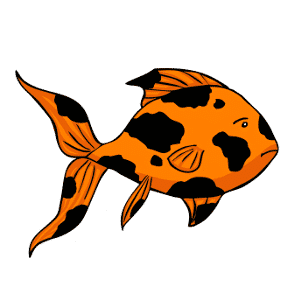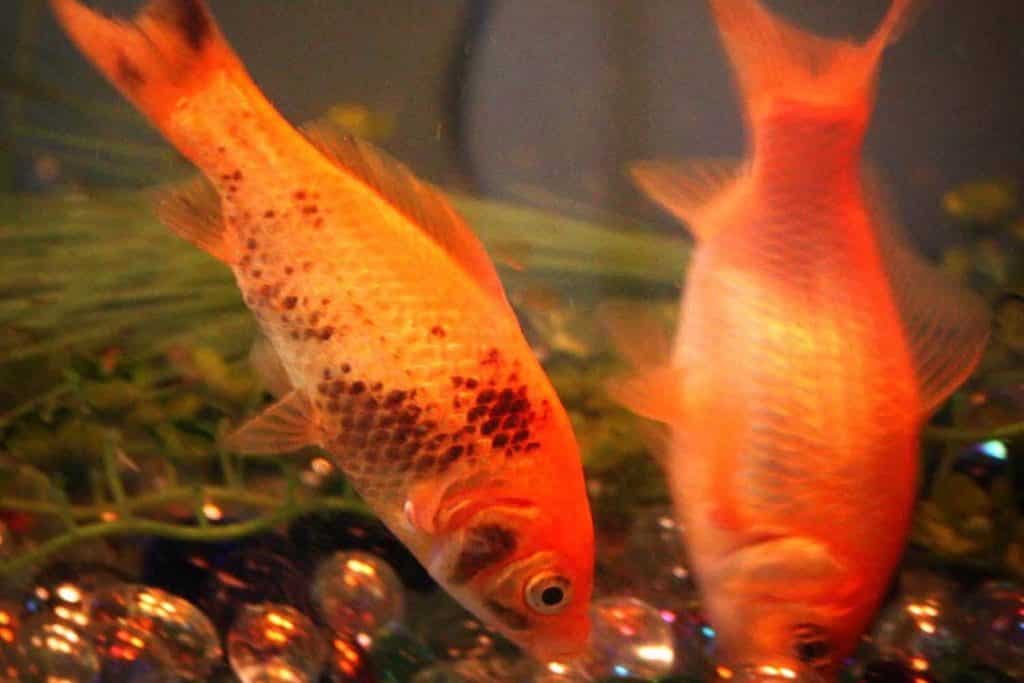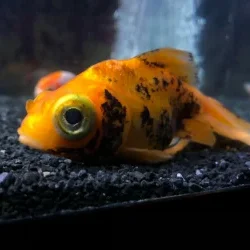You see your goldfish turning black and you’re worried. But should you be?
What does it mean when your goldfish turns black? And what should you do about it?
Let’s find out in our big guide to goldfish turning black!
In this article, we reveal the top 4 reasons why goldfish turn black, and – for each possible reason – we explain what you need to do to keep your fish safe and healthy.
Key Takeaways:
- Reasons for Goldfish Turning Black: Goldfish can turn black for several reasons, including ammonia burns, healing injuries, natural color changes, and black spot disease.
- Ammonia Burns: The most common reason for goldfish turning black. Ammonia burns occur due to poor water quality, and the black coloration indicates healing.
- Injuries: Black patches can form on goldfish as part of the healing process after an injury. If the injury is healing, the black marks are usually temporary.
- Natural Color Changes: Goldfish can naturally develop black markings as part of their life stages. These changes tend to be gradual and not associated with other health issues.
- Black Spot Disease: Though rare, black spot disease is caused by a parasitic infection, and is more likely in tanks with snails or in ponds. It’s different from ammonia burns or natural color changes.
- Prevention and Care: Regular tank maintenance, ensuring water quality, and addressing any injuries promptly can prevent most cases of goldfish turning black.
Table of Contents
Why is my goldfish turning black?
It’s not unusual for goldfish keepers to notice their goldfish turning black.
Black marks can appear on the head, the scales, and the tail, or you may notice your goldfish’s fins turning black.

Black marks suddenly appearing on your goldfish can be nothing to worry about, or they can be a sign of a serious problem. It’s therefore important to work out the reasons why your goldfish is turning black as quickly as possible and start treatment if necessary.
4 reasons why goldfish turn black
- Ammonia burns
- Healing from injury
- Natural coloration changes
- Black spot disease
Of these reasons, ammonia burn is by far the most common.
Unfortunately, ammonia burns are also extremely dangerous and often lethal. This is why it’s so important to act quickly to understand the reasons why your goldfish is turning black.
Below, we look at each of these four reasons in turn – including how to work out which reason is the one causing your goldfish to turn black and what you should do about it.
Goldfish turning black due to ammonia burns
Ammonia is a chemical found in your fish’s waste. It is highly hazardous to goldfish and can burn the fish all over its body.
When a goldfish suffers ammonia burn, its body tries to heal itself. This causes black patches on the goldfish in the same way that a burn on human skin might leave a scar.

To an extent, seeing your goldfish turning black is therefore a good sign. It means that the ammonia burn is healing!
However, if your fish was burned by ammonia once, you need to take steps to make sure it doesn’t happen again.
We’d recommend using API’s Freshwater Test Kit to make sure your water balance is correct.
How to tell if ammonia burn is the cause of your goldfish turning black
The first step to deciding whether ammonia burn is the reason behind your goldfish turning black is to do an ammonia test.
You should also test for nitrites and nitrates to see whether your tank is properly cycled.
High nitrite levels could be confirmation of ammonia burn, as they would suggest that your tank is not properly cycled and your fish may recently have experienced high ammonia levels. Nitrites themselves are also dangerous to goldfish.
We also recommend checking the size of your tank and confirming that it is suitable for the number and size of fish you are keeping.
If your tank is too small or over-stocked then you are likely to experience ammonia spikes, which will cause ammonia burn.
How to prevent ammonia burn
If your tank is set up well (including being properly cycled) and you perform regular water changes then there should be zero ammonia in your tank. Any ammonia released by your fish is quickly removed or turned into nitrites by bacteria.
However, if your tank is not cycled, contains too many fish, or is too small, then the ammonia levels will start to build up.
Unfortunately, it doesn’t take much ammonia to start burning your fish’s gills, scales, and fins.
A goldfish living in water containing ammonia will become stressed, have difficulty breathing, and will most likely die quite quickly.
The way to prevent ammonia burn is therefore to have a big enough tank, stick to sensible numbers of fish, make sure your tank is properly cycled, and perform regular partial water changes. This kit from JBL is brilliant for helping with regular water changes.
Never add untreated tap water to your tank (use Seachem Prime first) and never wash your filter sponges in tap water. This can kill ‘good bacteria’ built up during the cycling process and effectively un-cycle your tank.
Finally, test for ammonia, nitrites and nitrates regularly so that you always have a good understanding of your tank water conditions.
Goldfish turning black due to injuries
When a goldfish gets injured, its body attempts to heal itself, just like the human body does.
In humans, we see scabs and scar tissue developing at the point of the injury and we know this is a sign of healing.
In goldfish, this healing tissue is black. So, black patches on your goldfish can be a sign that your goldfish has been injured but is getting better.
If you know that your goldfish has recently been injured, and the black mark is in the same place as the injury, then this is almost definitely the reason why they are turning black.
If you don’t know of any injury, but think it’s possible that your goldfish could have been injured (for example, by a tank mate, in transport, or by an object in the tank) then you should watch your fish closely and remove the injury risk if possible.
If the injury is healing on its own – and that part of the goldfish turning black suggests that it is! – then there is usually no need to intervene and you can simply allow the injury to continue healing naturally.
Can goldfish be black or go black naturally?
It is possible for your goldfish to develop black spots, streaks, or patches entirely naturally.
They may be born with black patterns or these patterns might develop later in life, along with other colors and patterns.
A goldfish’s coloration generally changes throughout its life – at least to some extent – and part of this change including black marks is not necessarily a cause for concern.
There are also some types of goldfish that are supposed to be black or partly black. These include the Black Moor and other types with calico patterns, such as the Shubunkin.
It is usually easy to tell when your goldfish turning black is simply part of a natural coloration change. In these cases, the change is usually gradual, the black marks don’t look sore, and there are no changes in the behavior of the goldfish.
However, if you notice your goldfish turning black suddenly, the black marks appear to be associated with an injury, there are red marks too or other physical problems such as frayed fins, or your fish starts acting differently, then this is unlikely to be natural.
When black marks appear suddenly or alongside other physical or behavioral changes, they are far more likely to be caused by ammonia burn or injury.
Black Spot Disease: Why does my goldfish have black spots?
As explained above, by far the most common reason for black spots, black smudges or black patches appearing on your goldfish is the healing of ammonia burns or injuries.
Black spots are not usually a sign of a disease, sickness, or infection.
However, it is worth mentioning one possibility.
There is a disease known as ‘black spot disease’, which is a parasitic infection that causes black spots on fish.
But before you jump to the conclusion that your fish has black spot disease rather than ammonia burn, you should know that black spot disease is rare. (Unlike ammonia problems, which are very common!)
Your goldfish is only likely to suffer from black spot disease if it is kept in a tank with snails or in a pond. This is because the parasite’s lifecycle involves being passed in bird droppings, reaching water, where it infects snails, and then moving on to infect fish.
The infected fish are then eaten by other birds and the cycle continues.
As it is so rare, we strongly recommend considering other options before treating your goldfish for black spot disease. However, if you’re convinced that this is the reason for your goldfish turning black then a treatment such as PraziPro may help.
Featured image via Reddit.
Conclusion
In conclusion, if you’ve noticed your goldfish turning black, it’s crucial to understand that various factors could contribute to this change in coloration. Stress, poor water quality, genetics, and even age may play a role in altering the appearance of your aquatic companion. To address this issue effectively, start by assessing the conditions within your aquarium, ensuring optimal water quality, and providing a well-balanced diet.
FAQs
- Why do goldfish turn black?
- Goldfish may turn black due to various reasons, including natural color changes, environmental factors, stress, poor water quality, nutritional deficiencies, genetic factors, and even illnesses. Understanding the specific cause is crucial to addressing and preventing the color change.
- Will my goldfish stay black?
- Not necessarily. The article outlines strategies for restoring a goldfish’s original color, emphasizing patience and gradual changes to avoid stress. By addressing the root cause, maintaining optimal conditions, and providing proper care, there’s a good chance that your goldfish’s color can be restored over time.
- Do goldfish change color?
- Yes, goldfish can undergo natural color changes as they age. Additionally, environmental factors, stress, and health issues can contribute to color alterations. Recognizing the distinction between normal changes and potential problems is essential for proactive goldfish care.
- Do goldfish lose their black color?
- The article provides insights into the factors contributing to goldfish losing their black color. It discusses preventive measures, color restoration techniques, and the importance of maintaining a stimulating environment. By implementing these strategies, you can work towards preserving and enhancing the vibrant colors of your goldfish.

I’m am very concerned for my fish,she is white and I noticed she has a little black mark I have two other fish in the tank,Ashley the white one is the oldest so is this a case of death please email me so I could send a pic of the Problem because it is a concern I have about my Ashley
Hi Madison,
Changing colour isn’t a true indicator your fish is going to die, there will be other factors, goldfish change colour normally many times in their lives.
If you think they are old, goldfish live for 20+ years
if you are still concerned you can send us an image of your fish via our email address: speaktous@thegoldfishtank.com
my goldfish is turning black too and idk why but now i know btw ammonia found in po*p sorr i just don’t want to be rude
I have a oranda gold fish she has got a black line on top of her mouth. and her poo is realy black and i am desprate so pleas tell me what it is. Thank you
Hello, goldfish can develop black colours for many reasons, it could be age, it could be poor water quality, it could be recovery from disease.
we would ask you to test your water to see if it is okay, perhaps it is time for a water change.
As for the faeces being black, are you using any medications or feeding a specific food, sometimes these things can stain the bowel movements.
it is hard to tell without more information, if you want, you can send us an email through; speaktous@thegoldfishtank.com send us a picture if you can so we can better identify what is happening. there may be nothing wrong with your goldfish, or we may be able to give you better advice after having a better assessment of the situation.
Hello
Did you get an answer to your email – we have the same thing with our oranda goldfish – black line appeared on top of his mouth. Did the black line disappear on your fish? How is your oranda now?
Thank you
When I was Young, going to the mountains in the summer with my goldfish, the water would turn my goldfish black then it would die. The water comes from a pipe on the side of a mountain. Now, buying a mountain house, I brought my goldfish to a different town, and my goldfish started turning black. I brought it home and the color is going away. Not ammonia burn as I brought seeded filter media with me and changed 2 gallons daily. Something about the water,comes from a mountain. My goldfish is back home, full orange after 6 months. Thinking about re homing my goldfish before moving there permanently, but I hate to.
Hi Amy,
interesting story, sounds like there is something in the water that could be causing the colour change, it could be a number of different things that may be undetectable in an aquarium test kit, perhaps the pipes are polluted with chemicals or metals or perhaps the mineral content is too high.
It would be best to use a carbon filter attached to a hose pipe on tap water or treat it with a slightly higher dose of dechlorinator perhaps, in an extreme scenario, you can use bottled water from the store, just make sure it is not distilled water and that it does contain some minerals, as perfectly distilled water can kill your fish.
the colour change could also be your fish naturally changing colour as they mature, in which case it would be nothing to worry about.
hope this helps.
Hi. Regarding the black spots that are “scab from injury”: do they eventually disappear and the fish returns to its previous coloration, or does the healed area stay black? Thank you.
Hi,
I woke up this morning and noticed black on my goldfish I researched a bit to see what it was and I believe it is ammonia. I had run out of test strips and haven’t been able to get any today either. This afternoon I changed his filter and added some more water to it and as I was doing this I noticed a fair bit more black on my goldfish. Is it normal for the black to spread this quickly if my goldfish does have ammonia? And also if I changed the water a bit everyday would that help? Any if you have any other tips on how to help my goldfish can you please share.
Kindest Regards,
Mikayla Mclachlan
Oh and so sorry for the wrong word used in the last sentence I meant to use and.
Kindest Regards,
Mikayla McLachlan
My goldfish black fins side I want know what disease she got new color
Hello,
About a week ago sisters fish was floating upside down but still alive and I thought maybe he wasn’t fed so I put his food in and he started eating and acting normal. Today she noticed it has little black dots on it and it’s curled up and only one side of its fins are moving. Do you know what could be wrong with him and what we can do to help him? Plzzz